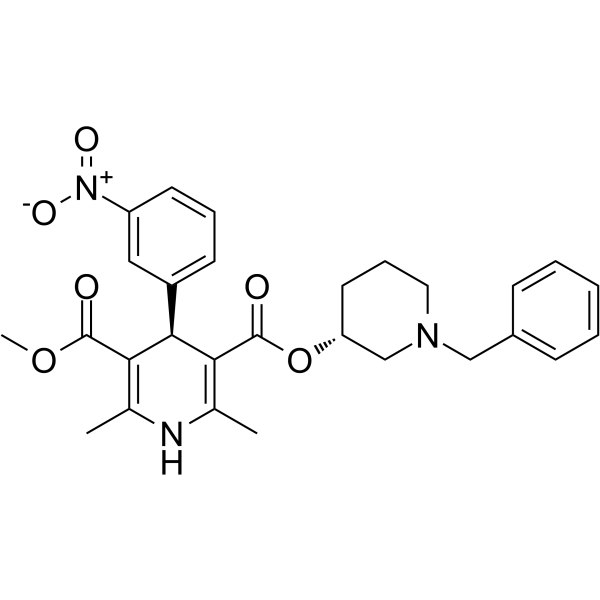Benidipine
Modify Date: 2024-01-06 23:01:46

Benidipine structure
|
Common Name | Benidipine | ||
|---|---|---|---|---|
| CAS Number | 105979-17-7 | Molecular Weight | 505.56 | |
| Density | 1.3±0.1 g/cm3 | Boiling Point | 625.2±55.0 °C at 760 mmHg | |
| Molecular Formula | C28H31N3O6 | Melting Point | N/A | |
| MSDS | N/A | Flash Point | 331.9±31.5 °C | |
Use of BenidipineBenidipine is a potent and orally active calcium channel antagonist[1]. Benidipine shows anti-apoptosis effects in ischaemic/reperfused myocardial cells[2]. Benidipine increases the activity of endothelial cell-type nitric oxide synthase and improves coronary circulation in hypertensive rats[3]. |
| Name | 5-O-[(3R)-1-benzylpiperidin-3-yl] 3-O-methyl (4R)-2,6-dimethyl-4-(3-nitrophenyl)-1,4-dihydropyridine-3,5-dicarboxylate |
|---|---|
| Synonym | More Synonyms |
| Description | Benidipine is a potent and orally active calcium channel antagonist[1]. Benidipine shows anti-apoptosis effects in ischaemic/reperfused myocardial cells[2]. Benidipine increases the activity of endothelial cell-type nitric oxide synthase and improves coronary circulation in hypertensive rats[3]. |
|---|---|
| Related Catalog | |
| In Vivo | Benidipine (3, 5, 10 µg/kg; i.v.) shows significant anti-apoptosis effects in a haemodynamically independent manner[2]. Benidipine (5 mg/kg; i.v.; every other day for 6 weeks) increases the activity of endothelial cell-type nitric oxide synthase (eNOS) and improves coronary circulation in hypertensive rats[3]. Benidipine (1, 3, 10 mg/kg; p.o.; once daily for 1 week) significant cardioprotective effects against ischemia-reperfusion injury[4]. Animal Model: Sham MI (myocardial ischaemia)/R (ischmia reperfused injury) rabbits and MI/R rabbits[2] Dosage: 3, 5, 10 µg/kg Administration: I.v. Result: Caused a significant decreased in HR ( heart rate), MABP (mean arterial blood pressure), PRI (pressure-rateindex) at 10 µg/kg, decreased apoptotic positive cells to7.4% at 3 µg/kg and not significantly different from that seen in the group treated with higher dose. Animal Model: Renovascular hypertensive rats (RHR)[3] Dosage: 5 mg/kg (dissolved in peanut oil) Administration: I.v.; every other day for 6 weeks Result: Significantly decreased the blood pressure and coronary vascular resistance index, but increased nitrite production and eNOS mRNA expression and significantly increased the coronary flow at rest, the capillary density. Animal Model: Rats (heart model (Langendorff perfusion))[4] Dosage: 1, 3, 10 mg/kg Administration: P.o.; once daily for 1 week Result: Significantly increased the post-ischemic recovery of LVDP and LV dP/dt max (LVDP: 87.5±10.1 vs 64.6±11.9%; LV dP/dt max: 97.8±10.4 vs 70.2±15.7%; p<0.05) at 3 mg/kg. |
| References |
| Density | 1.3±0.1 g/cm3 |
|---|---|
| Boiling Point | 625.2±55.0 °C at 760 mmHg |
| Molecular Formula | C28H31N3O6 |
| Molecular Weight | 505.56 |
| Flash Point | 331.9±31.5 °C |
| Exact Mass | 505.221283 |
| PSA | 113.69000 |
| LogP | 4.92 |
| Vapour Pressure | 0.0±1.8 mmHg at 25°C |
| Index of Refraction | 1.622 |
| WGK Germany | 3 |
|---|
| Benidipene |
| (+/-)-(R*)-3-[(R*)-1-benzyl-3-piperidyl] methyl-1,4-dihydro-2,6-dimethyl-4-(m-nitrophenyl)-3,5-pyridinedicarboxylate hydrochloride |
| (3R)-1-Benzylpiperidin-3-yl methyl (4R)-2,6-dimethyl-4-(3-nitrophenyl)-1,4-dihydropyridine-3,5-dicarboxylate |
| 3,5-Pyridinedicarboxylic acid, 1,4-dihydro-2,6-dimethyl-4-(3-nitrophenyl)-, methyl (3R)-1-(phenylmethyl)-3-piperidinyl ester, (4R)- |
| methyl (3R)-1-(phenylmethyl)piperidin-3-yl (4R)-2,6-dimethyl-4-(3-nitrophenyl)-1,4-dihydropyridine-3,5-dicarboxylate |
| MFCD00906929 |
| (3R)-1-Benzyl-3-piperidinyl methyl (4R)-2,6-dimethyl-4-(3-nitrophenyl)-1,4-dihydro-3,5-pyridinedicarboxylate |
| Coniel |
| (R*,R*)-(±)-1,4-Dihydro-2,6-dimethyl-4-(3-nitrophenyl)-3,5-pyridinedicarboxylic Acid Methyl 1-(Phenylmethyl)-3-piperidinyl Ester |
| Benidipine |
| H007 |
| UNII:4G9T91JS7E |